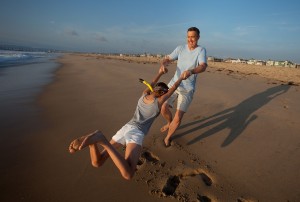Now this is pretty impressive. In a recent study detailed in a NY Times article, researchers found that 80 year olds who were considered world class athletes (for their age group) had significantly more muscle mass and strength than 80 year olds who were classified as just healthy. In my mind this raises a few interesting points. First, there’s a subset of octogenarians that are world class athletes! Who knew? All kidding aside, this is a testament to the increasing age expectancy and increased awareness of the importance of health and wellness into our later stages. There are more opportunities for 80 year olds to compete and train, which is wonderful. Then there’s the chicken/egg question. Are these folks stronger and more muscular because they train or can they train because they are genetically gifted with more and stronger muscles? The linked article is unclear on this. But it’s exciting to see that significant exercise and movement in our 80s is both possible and healthful. Movement is important as we age.
Glory Days
Sad lyrics set to a peppy tune. But maybe the lyrics aren’t so sad after all. In a recent study on mice, activating happy memories increased long-term resilience to stress even more effectively than actually experiencing a new happy event. This could explain why we like to sit on bar stools and reminisce about the gold ole days or maybe why little kids love to hear the same story over and over. The next time you’re feeling down in the dumps it might make sense to try some relaxation techniques followed up with spending time thinking about happy memories. Glory days indeed.
Another Life Saving, Health and Finance Compromising Miracle Drug?
The FDA Advisory Panel recently recommended that a new class of cholesterol drugs, alirocumab (Praluent) from Sanofi SA and Regeneron Pharmaceuticals Inc., be approved. The new drugs are given by injection and work by blocking an enzyme. The results are pretty impressive. But at what cost? I’m certain the very smart folks working at big Pharmas and their billion dollar statin franchises are aware of the controversy around statins and are starting to wonder where the next cholesterol money making opportunity will be. This could be it. This drug will be effective at lowering LDL (bad cholesterol) but also cost an enormous amount. So the drug companies may be killing two birds with one stone here 1) create a new franchise 2) treat fewer people and protect against the over prescription controversy. I think the second point is an important one. The greed of the Pharmas and their desire to get more and more people taking statins was obscene. So good on them if they curtail that. But the profit potential for these drugs looks pretty tantalizing and in the end who will pay for these new potentially $12,000 a year drugs? All of us, regardless of whether we take them. Once again, the massive healthcare costs will need to be absorbed by insurance – meaning rates will probably rise or standards cut. But at least the Pharmas will make billions, Hooray!
Of course this also glorifies the magic bullet theory. Eat and live like crap because we’ll find a drug that makes it all ok. Yes this is an oversimplification and for some this drug could be a lifesaver. But emphasizing magic bullets over real and effective lifestyle changes, not food pyramid bullpoop, could be just as effective for the entire population. And what about the mechanism that makes this drug work, blocking that particular enzyme? Is there any chance that could have unforeseen negative consequences too? I want to embrace new technologies and breakthroughs, but when I consider how it could all play out, I scratch my head a bit.
When I Know Living Healthy Is Working
We were at Rehoboth Beach over Memorial Day Weekend. It’s my favorite beach town on the east coast. There’s a boardwalk, rides, and appropriately unhealthy beach foods. My family loves it there. On a warm night after everyone has walked around, crashed their bumper cars like vengeful NASCAR drivers and ridden The Sea Witch (back row only) one too many times, my kids love to get ice cream.
On this particular night my son had gone back to where we were staying already. So my daughter and I went to get ice cream without him. Even though he didn’t ask me, I decided to get my son a scoop of chocolate on a cone to surprise him. So I paid up, took the dripping cone, gently placed it in a cup, stuck a spoon into the melting ice cream and we started our way home. My daughter smiled and proceeded to devour her cone, waxing on about the deliciousness, a cross between Hemingway, Julia Childs and Dick Vitale. I held my son’s ice cream in front of me, as my daughter continued her detailed descriptions of the sweet, cool, creamy concoction. I walked step after step, through the warm evening air, swimming in the sounds of the beach with that red plastic spoon handle tilted toward me. Seemingly moving closer and closer to my hand as the ice cream swooned and softened.
The Ice Cream made it to my son untouched. Actually, I was never even tempted. I had already eaten a great piece of fish with perfectly charred asparagus on the side. I had no desire for the ice cream. Zero. Seriously. For those of you who have never eaten paleo/primal/ancestral/whole you may not believe this, but you do reach that point. You don’t want to eat pizza and fries and ice cream. It’s no longer a feeling of depriving yourself. You just don’t want it. When you hit that point you’ve got a really good chance of sticking with your program.
Healthy Relationships. Should These be the Foundation?
The power of relationships is so personal, intuitive and innate that I think it’s easy to take it for granted and to lose perspective on how it effects your life. I believe most people understand that positive and negative relationships can influence how you feel day to day, but the impact of healthy relationships may be even greater and wider ranging than many thought – down to a cellular level.
One recent study (the appropriately named Longevity Project) shows that healthy relationships above all else, including diet and exercise, will help determine your longevity. The authors studied more than eight decades worth of data on 1500 Californians and found that “it is responsible, goal-oriented citizens, well-integrated into their communities” who are most likely to have long, healthy lives according to researcher Howard Friedman.
The list of studies linking good relationships to positive health outcomes is a long one:
Married People Have Less Heart Attacks
Long Term Relationships Better for Mental and Physical Health
Married People Recover Better from Surgery
Committed Relationships Have Less Stress Hormones
These are just scratching the surface. And though many of these studies focused on married couples, the point seems to be more about the strength of the relationship than the legal contract. Knowing the impact of relationships on your health, happiness and longevity are one thing, actively managing and approaching your relationships the way you actively approach diet or exercise is another. And not just for yourself, but for the people you are connecting with. What if we decided to spend 30 minutes a day focused solely on building healthy relationships? Seems like a promising idea on many levels.
Eat a diet, don’t be on one.
Eating well is a gift. To every part of you. Not only does real, healthy food taste better but the best diet protocols are the single greatest measure to help people get and stay healthy. For many, “eating healthy” is the gateway to weight loss. The key is that choosing a healthy diet is not about “dieting”. No counting calories. No starving yourself. This is a fantastic benefit to ancestral, whole food diets! They almost universally eliminate most of the pseudo processed foods that trick our bodies into craving more empty-calorie, insulin disrupting junk. No craving means no starving! Healthy diets allow you to eat well. And if you have no desire to lose weight, no worries. Eating the right way tends to normalize your weight at a healthy point so you look and feel great the way your body is meant to. Now if you want to gain weight you can do that too with a smart diet. And still remain very healthy.
To understand this better we need to know about the problems with the Standard American Diet (SAD – I love that acronym) Here’s a ridiculously simplified version of why we get fat on the SAD. Many of the foods in the SAD are literally engineered to make you crave more of that food. SAD foods tend to be made of the same highly processed ingredients that don’t nourish our bodies, a lot of sugar, refined oils and soy-corn-wheat monocrop. If you look at the labels of everything the average American eats in a day you’ll be blown away by how much of it is soy-corn-wheat , crappy oils and sugars. This consistently bad and limited diet deprives our bodies of important nutrients and throws our metabolism and hormones out of whack. It’s an overwhelming amount of the same bad stuff. So our bodies react adversely, searching for nutrition and trying to figure out what to do with all the crap. The net is we wind up wanting to overeat to get more nutrition and at the same time signaling our bodies to store all the excess as fat. Then to try losing weight, many resort to forcing themselves to eat fewer calories of the same bad foods, which only exacerbates the lack of nutrition. We wind up starving our bodies and forcing them to feed on themselves not just for fat but for nutrients and more.
On the flip side, ancestral whole food diets are focused on the quality of the foods, not the quantity. By focusing on quality and variety many improvements in health can happen. And happen quickly. Many people report increased energy, better moods, better health makers and of course weight loss. It’s one of the first tenets of regaining your health, embracing whole, high quality, unprocessed foods. Those diets that are rooted in this belief are the right way to eat. There are many to choose from. I don’t like getting caught up in the subtleties of diet arguments. In fact I think its probably a good idea to switch things up every now and again. No matter what diet you work with, focus on food quality over food quantity. Don’t “diet”. Eat the right foods, eliminate the bad and very good things will happen.
My favorite “diets” that aren’t about dieting
I’d love to know yours.
Think Positive And Grow Really Old
It may sound like a self help guru script but there is very serious science coming out about the role positive thinking and stress reduction and how they can help us live longer, happier and even healthier lives. Of all the pillars in the Healthi Happi life this one may seem the easiest to ignore but it may in fact be the most important. It’s not hard to imagine how the thinking loop works. When you have a positive frame of mind you are more likely to try something healthful. The positive frame of mind also makes it more likely the healthful choice succeeds. The success reinforces the positivity. And thus the cycle continues. The negative loop cycle is just as powerful and may even have a similar effect as eating fried GMO frankenfoods day after day or never exercising. Be negative, stressed and under extreme pressure for long periods and it will very likely do your body a lot of harm.
Of course our bodies are designed to handle some stress. Occasional stressors actually help us get stronger and healthier. The problem occurs when we have heavy stresses with out a break. Just as your body needs rest after exercise, your mind and body need moments of calm and/or positivity after extreme mental stress.
The great news is when you find those moments of calm, happiness and positivity they can have dramatic effects. Studies have shown that certain types of meditation can lower body inflammation and that your attitude has a direct effect on the length of your telomeres (basically negative thinking equals shorter telomeres equals shorter life). People with positive attitudes towards aging lived 7.5 years longer than those who didn’t in another study. Optimists had a 50% lower rate of early death. List of studies goes on and on. We may not yet understand how it all works but it’s becoming clearer every day how much mental outlook and reducing stress plays a role in our health. The science is just too great to treat it any way differently than you treat diet and exercise. It needs to become a pillar of your health regimen.
Paleo finance and Ancestral Investing. Yes I just said that.
As in dieting and movement, you can think of finances from a Paleo or ancestral perspective. Bear with me on this, it will make sense. Our ancestors may have not been investors as we understand them today, but they had to make critical choices on how they expended what little resources they had and what few assets they would accumulate. Kind of like us! For the most part the choices they made reflected acquiring assets that had long term or continuous value. 20,000 years ago tools, spears and hides were of paramount value. Think about it, a Neanderthal with a particularly strong and durable spear had a very precious and rewarding commodity, one that could bring returns like food or clothing for a long time. A very good investment indeed. The assets our forefathers acquired returned continuous value. In harsh conditions, hoarding goods that could not return long term value was more than frivolous, it was potentially dangerous. I think we can learn a lot from this. If you adopt a philosophy that your resources should be primarily spent acquiring assets that return significant value you will be well on your way to financial success. Invest like a caveman! Because investing is arguably the most important tool in your path to happi healthi finances.
Put simply, if you want control of your financial future you need to build assets. There are lots of paths to doing this, including investing in stocks or starting your own business. Whatever path you choose to build your financial future, the best way to succeed is to have a plan and diligently execute it. Write your plan down. Revisit it frequently. Know it and live it. This is very important. Without a plan your chances of succeeding get a lot slimmer. Doing nothing and hoping for the best is not a plan. Here are my fundamentals to help you start your plan.
1) Save and build your assets. Start today. Assets are the key. While there are many ways people have achieved financial success, in my opinion, the best way for most people is through the ownership of appreciating assets. Businesses, Stocks, bonds, ETFs, mutual funds, real estate, commodities are asset classes that historically have appreciated. Cars, Comic books, high end clothing, other consumables, tend to depreciate – meaning they lose value over time. Not good investments. It’s better to spend money on owning things that increase in value. Seems pretty simple but are you doing it? Are you making it a priority? Even if you are just starting with $500, open a brokerage account and start now. Max out your 401K at work if you have a 401K. Whether it’s $5 a week or $500, consistently save so you can take that money and build assets. For most people ownership of Stocks, Mutual Funds or (my favorite) ETFs are excellent choices to begin with. For the average American the largest asset is often their home. It’s the American dream. But remember its only one of the many assets classes you can and probably should consider owning.
If you can, save 10% of your income every year.
How do I personally invest my precious resources? Here’s my happihealthi spending hierarchy
1a) Necessities (rent, utilities, transportation, the kids, etc.)
1b) Healthy foods
2) Assets that appreciate
3) Great experiences
4) Assets that depreciate slowly
5) Anything that depreciates quickly
Assets that depreciate slowly include things that you’ll get a great deal of use out of like high quality clothes that you’ll wear a long time (and fit into a long time because you are eating the right way!)
2) Live below your means. For some this may be difficult or impossible. But as you continue to improve your financial situation it can become more possible to do. Just do it as soon as you can. Then take the savings and build your assets. Never “Keep up with the Jones.” It doesn’t matter what they wear, drive or look like. Live below your means, build your assets, and retire before the Joneses. I think this is one of the biggest barriers we have to building assets – comparison to others and our need to spend to compete with them. As Kierkegard said “Comparison is the root of all man’s unhappiness” Don’t fall into this trap. It’s ok to drive somewhere in an old Honda when everyone else is driving a new Mercedes. You both still arrive at the same place.
3) Diversify. This sounds cliché but it really is critical. In large part for protection. You don’t want all of your money in your house when the Real Estate market turns against you. Real Estate is historically around a 17 year cycle from peak to trough. That’s a long time to wait to recoup all your money. I’m not singling Real Estate out. Im just using it as an example. Fortunately different asset classes usually have different cycles and can move in opposite directions. So when one is down the others may not be fairing as poorly some may even be rising!
4) Attempt to eliminate extraneous costs wherever possible. Take the savings and build your assets. Everyone has unnecessary costs. Paying too much rent or property taxes, leasing instead of buying autos, paying cable bills when you can get your favorite programs on the web etc. Many expenses are life style choices. That’s ok. But seriously consider whether you need them. If you can live without them do it. BTW, this applies to investing too. Be aware of fees when investing. Some mutual funds are notorious for having very high fees. Those fees will cut into your returns. ETFs are the better choice in my opinion. Always look to eliminate or reduce fees and costs.
5) Understand your time frame and stick with it! This is one of the biggest mistakes investors make. Don’t buy a long term asset and then get nervous about short term moves.
6) Don’t watch CNBC or other financial news shows for investment advice. They don’t know you, don’t care about you and can’t help you. It’s entertainment only. I’ve seen reports of people tracking these tv celeb stock pickers and the results are not impressive. Their goal and motivation is to get viewers, not to help you.
Related: When it comes to great stocks – “Those who tell don’t know. Those who know don’t tell.”
7) “Buy low sell high” still holds true. Yet most of us do the opposite in the market. We buy when others are buying and prices are high. We sell when everyone else is selling and prices are low. Another way to think of this perverse phenomenon with appreciating assets is to compare it them other things we purchase (eg. shoes or cars). We love when shoes or cars go on sale but when tradable assets like stocks go on sale (by dropping significantly in value, sometimes called a “correction” or at worst a “crash”) many get afraid and want to sell them! Now if a TV price drops 50% we line up at 4 am the day after Thanksgiving! Hmmmmm. Change your mentality. Be a long term investor and don’t panic. If anything, be opportunistic and start looking to acquire inexpensive assets you believe in. As a long term investor those few times you feel panic are often buying opportunities. What happens to great stocks in crashes and corrections? For the long term investor they eventually come back a lot higher!
8) You don’t need a stock broker or financial advisor. Unless you have a lot of money. And until then you can do very well with just yourself and if needed, a good accountant you trust.
9) Did I mention save money, build your assets and write down a plan?
I believe Paleo Investing or Ancestral Investing is a good mind set for long term financial success. Consider your resources to be scarce and precious. Use them to acquire assets that will continue to return real value. Invest like a caveman!
Get Moving. Then Get Resting.
I’m not an athlete. I always wondered how important being athletic was for keeping fit. Was my lack of athletic skill going to keep me from enjoying exercise and keep me from getting healthy? Many of the top health bloggers I followed and learned from were serious athletes at some point in their lives. Not me. I also noticed that those dramatic before and after pics of guys who lost weight and then looked really muscular usually showed that they were fairly muscular to begin with. Again, not me. So what’s an average or really below average athlete like myself supposed to do? Fortunately it’s a simple answer: get moving.
Yes, that’s an oversimplification. But not as bad as many would have you believe. We don’t need to go to a gym for an hour five days a week. In fact studies have shown that exercising properly for just one minute a few times a week can have significant results.
I like to think of movement in three buckets: Heavy, Fast, Slow. If you do a little of each throughout the week and don’t stress over it you’ll do pretty well. Definitely have goals. But for someone who wants to be happy and healthy if you miss a set or need to skip a day, its ok. For those of you who want to maximize performance gains, there are lots of websites to get very specific info and routines. But I’m probably not the guy for that.
One huge caveat – the phrase “listen to your body” really applies here. If it starts to hurt stop doing it. If you feel sick, don’t exercise. Bodies need rest and they often let you know when.
HEAVY – This is strength training using weights of some sort. I like using my body weight but free weights, dumbells, kettle balls, jugs of water etc. all work well. Just don’t use machines. They restrict motion and you want your body to move freely. A smart way to strength train more efficiently is to use compound movements. These are movements that work more than one muscle group like pull ups, push ups, squats or hanging leg lifts. (btw just doing those four is a pretty decent routine) Basically do the exercise until you can’t anymore. Then rest until you can do another set or switch to a different exercise that works different muscles. Then alternate between them. 3-5 sets is what most recommend. If you can do more than 20 reps at a time you need to make it more challenging, usually by adding weight.
FAST – Basically “sprinting”. This means all out exertion for a short period of time. Usually done with leg heavy exercises like running or jumping. Try running hard for 30 seconds then resting for 60 seconds. Do this as many times as you can up to 10 sprints. Start small and work your way up. If you could only do one type of exercise this would be the choice. Sprints followed by short rests have a great effect on many of the hormones that play pivot roles in our health.
SLOW – This means easy continuous, longer duration movement. Like walking or riding a bike. Its really hard to find fault with walking as an exercise. Our bodies are designed for walking. Its kinda our thing as humans. So do it. Whenever you can. My other favorite “slow” is yoga. For those who are skeptical, meaning men, its tougher than you think and has many benefits you’ll really appreciate like greater flexibility and balance and I always get this remarkable sense of calm.
One of the best things about exercising this way is that its really cheap and flexible. Do pull ups from a tree branch. Do push ups anywhere. Sprint down your street or in a park. Take a free yoga class (keyword “Vinyasa”) from youtube.
Remember this mini-guide was not written for serious athletes or anyone training for performance. That’s a whole different mindset. But its one that gets promoted a lot – “no pain no gain.” The problem with that is the majority of us don’t need to think like that. In fact it could wind up hurting you, or setting you back through injury. That can be frustrating and discouraging. You don’t need to think that way. Just get moving, and don’t stress over it. Mix in some strength movements and the occasional sprint and you’ll be well on your way to improved health.
My Philosophy
Aging is the accumulation of damage to your cells, your psyche and your finances.
So take control of your health, happiness and finances. You can thwart and even reverse some of these damages.
Eat whole. Health is largely dependent on diet. Most of us eat an unhealthy diet that contributes greatly to our medical and psychological issues. Change to a diet that emphasizes whole, natural, less processed foods and limits consumption of any single food group (think grains). There are many. It takes experimentation to find what works for you.
Move more. And do it naturally. The sedentary life is also contributing to health and happiness issues. Get out and play in the fresh air and sun. Mix it up if you can. You may not really need more than that. But feel free.
Be connected. Enjoy time and experiences with friends, family and associates. But put friends and family first. Do things to help others.
Eliminate stresses. Some are unavoidable some are very avoidable, many are self induced. Stop doing that. And sleep more.
Be skeptical. Be your own advocate when it comes to health care. The medical and health care industry is a mixed bag ranging from brilliant and life saving to unnecessary and crippling. Question everything and search out credible alternatives before deciding on therapies. Make highly informed choices when it comes to healthcare.
Actively manage your finances. Plan and understand what your money is doing and know exactly why and how. Understand and eliminate drains on your money. Find smart, safe places to keep your savings. Find smart, honest, trustworthy advisers.








